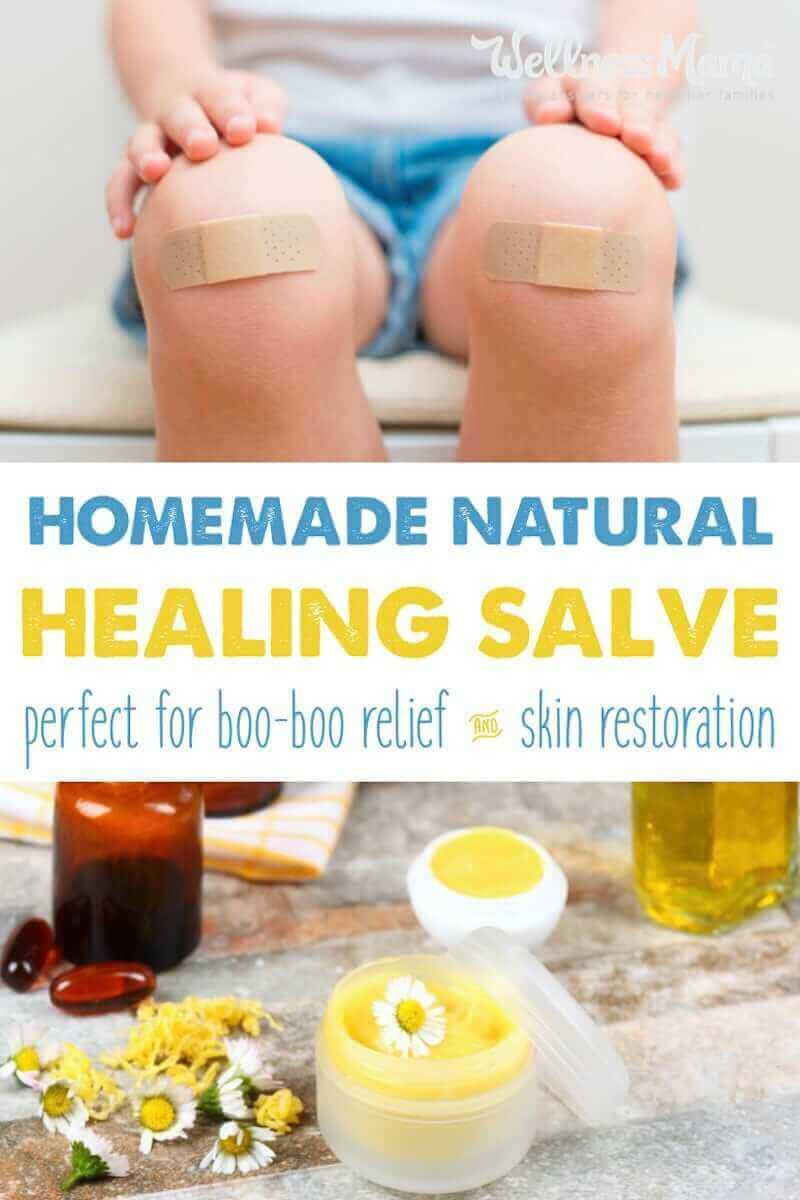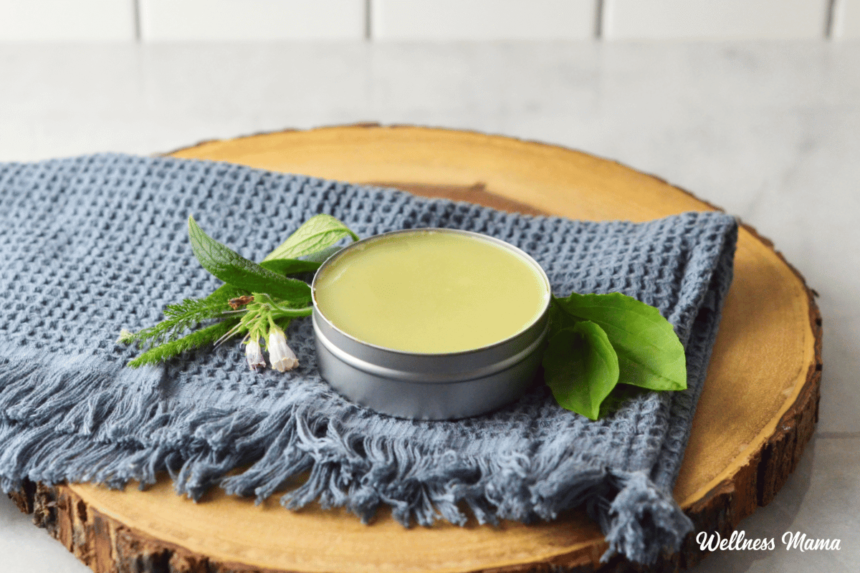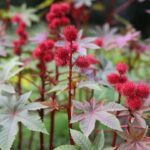Last week, within the span of one day, three of my kids needed a Band-Aid for some reason. With six kids who like to climb, jump, and live in their treehouse, this is a common occurrence. I decided to find a natural salve option to use instead of conventional ones like Neosporin.
How to Use a Healing Salve
I’m not a fan of Neosporin because it’s made with petroleum jelly. Plus there are plenty of natural options that work just as well.
My homemade healing salve (or “boo-boo lotion”, according to the kids) is helpful on cuts, bruises, stings, poison ivy, and skin irritations. It also helps with diaper rash and baby skin irritations. For cloth diapers be sure to line them with a disposable liner first.
This herbal healing salve is also great for eczema, scrapes, abrasions, and insect bites. And it’s moisturizing to dry skin and cuticles. If there’s a problem and it’s with your skin, this healing salve is likely to help.
Healing Salve Herbs
So how can one salve do so much? The healing herbs here are naturally antibiotic, anti-inflammatory, anti-fungal, and astringent. This makes it perfect for any herbalist’s first aid kit.
- Echinacea – Antimicrobial, analgesic, and anti-inflammatory. Can help prevent infection from venomous snakes and insects from spreading. Good for burns. At risk in the wild so choose cultivated sources (or grow your own!).
- Comfrey – Nicknamed bone-knit for its ability to heal broken bones so quickly. Stimulates tissue repair for fast healing. Used for sprains, swelling, and bruises, anti-inflammatory, antiseptic.
- Plantain – Dubbed “Indian Band-Aid” by the Cherokee. Good for bites, stings, cuts, and scrapes, poison ivy, and sunburn. A plantain poultice helps draw out splinters and stingers. Stimulates collagen growth for faster wound healing.
- Calendula – Anti-inflammatory, astringent (tightens loose tissues), antibacterial, antiviral, and antifungal. Used for cuts, burns, diaper rash, bites, sprains, bruises, rashes, sunburns, abrasions, and slow-healing wounds.
- Yarrow – Helps restore stagnant or congested blood flow while also helping staunch bleeding. A vulnerary, antimicrobial, anti-inflammatory, astringent, and relieves pain.
- Rosemary – Antiseptic, antibacterial, antifungal. Shows positive results against drug-resistant infections. Stimulates blood flow to the area, and eases muscle pain and inflamed joints. Also good for sores, bruises, wounds, eczema, and sprains.
Note on Comfrey
Because comfrey can heal skin so quickly it’s important to use it along with other herbs. You don’t want the skin to heal so fast that it seals infection in. By using antimicrobial herbs like rosemary and echinacea it helps prevent this issue.
Other Ingredients
You can also add some lavender essential oil or tea tree oil for extra skin benefits. Lavender is a natural antihistamine so it’s great for soothing itchy skin and bites. Tea tree is a potent anti-fungal and it also offers some soothing itch relief. You can use any skin-friendly blend of essential oils you prefer in this. Frankincense, chamomile, and helichrysum are some more options.
It’s easy to make and some of the ingredients even grow in your front yard during the summer One of the herbs I use is Plantain, which grows in most of the US and is great for the skin. You may also be able to find yarrow growing wild in your area. All of the above herbs are useful for lots of things and some can also be used internally or in food.
Almost any liquid oil will work in this recipe but I usually use olive oil. If you use coconut oil you may want to reduce the beeswax some or it can get too hard in cooler temperatures. Sunflower oil, almond oil, and grapeseed oil are more options.
Choosing Your Container
Salve goes well in metal tins or in a glass jar. I prefer the tins for easy travel and I don’t have to worry about a glass jar breaking. Lip balm tubes are another great option. These make it really portable and easy to apply.
Healing Salve Recipe
This healing salve is a natural alternative to antibiotic ointments. Great for all kinds of cuts, scrapes, rashes, and more.
Yield: 2 cups
Infuse the Herbs
-
Combine the olive oil and herbs in a jar with an airtight lid and leave for 3-4 weeks, shaking daily. This option doesn’t work well with coconut oil.
-
OR heat the olive oil (or other oil) and herbs over low heat in a double boiler for 3 hours (low heat!) until the oil is very green.
-
Another option is to put the herbs and oil in mason jars with lids. Place in a water bath in a crockpot set to low and let this infuse for at least 24 hours. Refill the water in the slow cooker as needed.
Make the Salve
-
Pour the oil through a cheesecloth and strain out the herbs. Squeeze the cheesecloth to get as much oil out as possible.
-
Compost the herbs.
-
Combine the infused oil and beeswax in a double boiler.
-
Heat over low heat, stirring occasionally, until the wax is melted.
-
Add essential oils if desired.
-
Pour into small tins, glass jars, or lip balm tubes and use as needed.
Store in a cool, dry place for up to 2 years.
Storage and Shelf Life
This healing salve lasts for a year or more when stored properly, so I make it in big batches. However, you can reduce the size if needed. I always keep this on hand when I’m gardening for skin irritations and bug bites. Be sure to store it in a cool, dry place away from light and heat.
Adding some Vitamin E helps extend the shelf-life and keeps the oils from going rancid as quickly.
Ever made your own salves? Share below!






